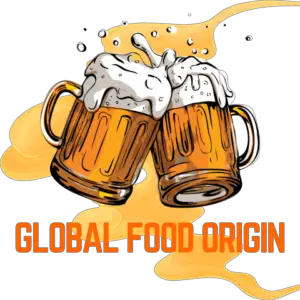Chicken Alfredo is a yummy pasta dish that’s really popular in America, but it actually started in Italy. A man named Alfredo di Lelio made the first version, called Fettuccine Alfredo, in his restaurant in Rome. Famous movie stars tried it and loved it, so they told people in America about it.
When the pasta dish came to America, it changed a bit. People added chicken to it, which wasn’t in the original recipe. This shows how recipes can change when they move to different places.
Now, lots of people know about Chicken Alfredo and you can find it in many restaurants. Sometimes, chefs like to change the recipe a little to make it even more delicious or different, like adding vegetables or different kinds of cheese. It’s fun to see how a simple dish from Italy became so loved everywhere!
Fettuccine Alfredo: A Classic Italian Dish
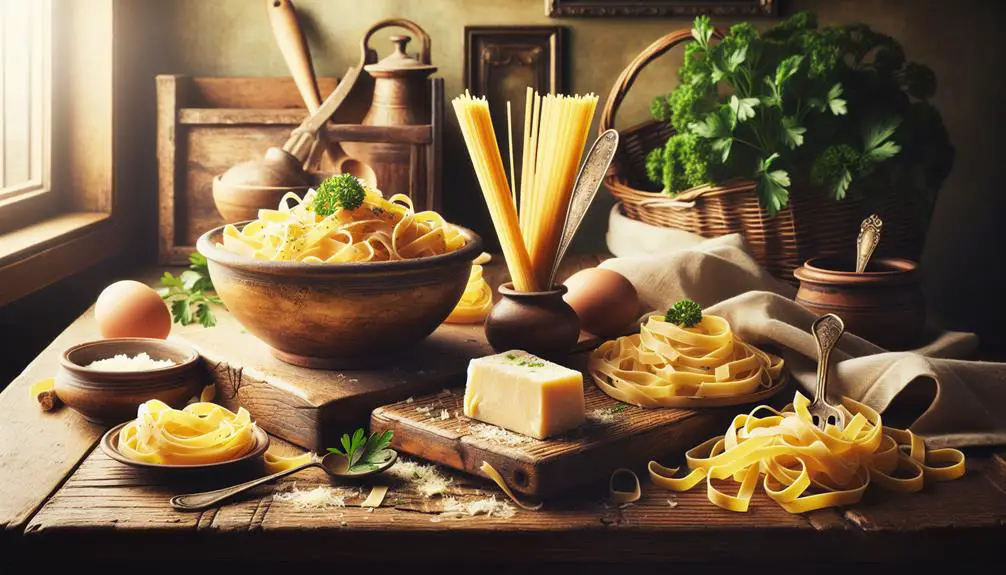
Fettuccine Alfredo is a famous dish from Italy, made with just three main ingredients: fettuccine noodles, Parmesan cheese, and butter. A long time ago, a man named Alfredo Di Lelio made this dish popular at his restaurant in Rome. He called it ‘fettuccine al burro,’ which means fettuccine with butter.
Even though this dish is simple, it has a special way of mixing the ingredients. The pasta mixes with the butter and cheese to make a creamy sauce that sticks to the noodles.
People think that fettuccine Alfredo came from an older recipe in Rome. Alfredo Di Lelio made it famous because it tasted so good and rich, yet it remained simple. When you mix the butter and cheese the right way, they come together to make a smooth sauce without needing anything else to make it thicker.
To make this dish really good, you need to use the best cheese with a strong flavor and butter that is not salty and has lots of fat.
Origin of Fettuccine Alfredo

The dish called Fettuccine Alfredo was made famous in a restaurant in Rome by a chef named Alfredo Di Lelio. Back in 1914, Alfredo was a really good cook who had his own restaurant in Rome. He made a special dish with fettuccine pasta, Parmesan cheese, and butter for his wife, Ines, to help her feel better after having their baby. The meal was simple but very comforting and helped Ines recover.
The story of this dish is pretty special because it was made with love and care. The way the butter and cheese came together on the pasta made it really yummy. After Alfredo made it for his wife, other people at his restaurant started to love it too. It got so popular that they named the dish after Alfredo.
Now, Fettuccine Alfredo is known all over the world, not just in Rome. It’s famous for being a simple but delicious meal that started in Alfredo’s restaurant a long time ago.
Popularity in the United States

Fettuccine Alfredo became famous in the United States in 1927 when famous silent movie stars, Mary Pickford and Douglas Fairbanks, visited Alfredo Di Lelio’s restaurant in Rome while they were on their honeymoon. They loved his special pasta dish. This was the start of Fettuccine Alfredo becoming popular in the U.S.
Mary Pickford and Douglas Fairbanks were very famous and important in the early movie world. They really liked the Fettuccine Alfredo and told their friends in Hollywood about it. Because of this, lots of people in America started to like it too. The chef, Alfredo Di Lelio, got famous and was called ‘Alfredo the King of Noodles.’ The famous couple helped make this yummy dish very popular in the U.S.
Now, many people in America love to eat Fettuccine Alfredo, and it’s not just for fancy dinners but for regular meals too. It’s a dish that shows how food from one country can become a favorite in another country.
Adaptations and Commercialization
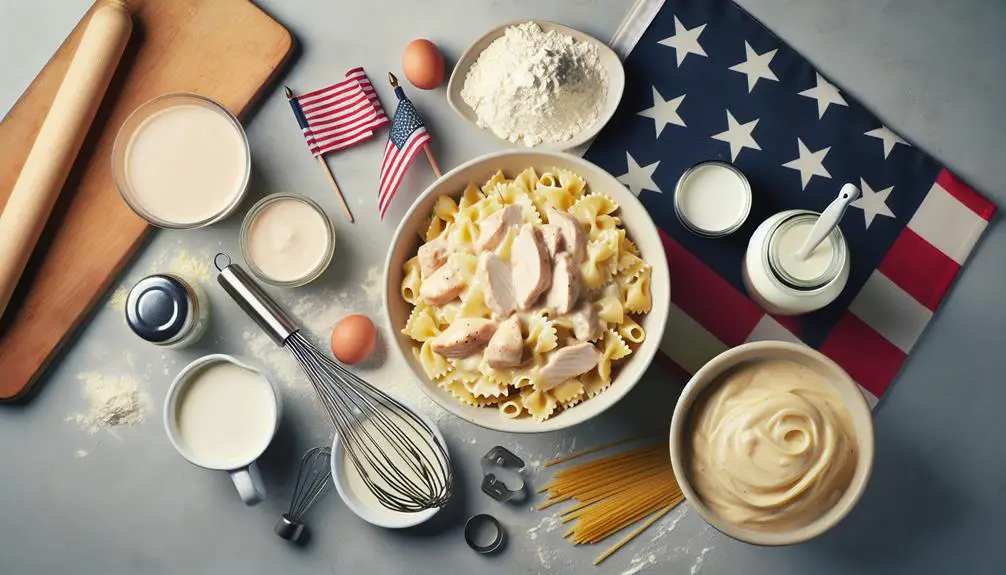
As the palate of American diners evolved, the classic Italian dish underwent significant transformation, most notably through the addition of heavy cream to the sauce, marking the transition of Fettuccine Alfredo from its Roman roots to a staple of Italian-American cuisine.
This culinary adaptation not only catered to the American preference for richer and creamier sauces but also signified a departure from the origin of Fettuccine Alfredo, which traditionally consisted of only pasta, butter, and cheese.
The introduction of heavy cream, a practice not found in Alfredo Di Lelio’s original recipe, exemplifies how cultural and taste preferences influence the gastronomic landscape.
Subsequent adaptations and commercialization efforts further entrenched Alfredo sauce within the American culinary vernacular.
Commercial Alfredo sauces emerged, often employing thickening agents such as flour or cornstarch to achieve a consistency appealing to consumers while also extending shelf life.
These prepared sauces offered a convenient, albeit altered, version of the classic, facilitating the dish’s proliferation across various dining platforms.
The American actors who initially heralded the dish provided an inadvertent catalyst for its transformation into a dish that is now emblematic of Italian-American cuisine’s adaptability and widespread appeal.
Modern Variations
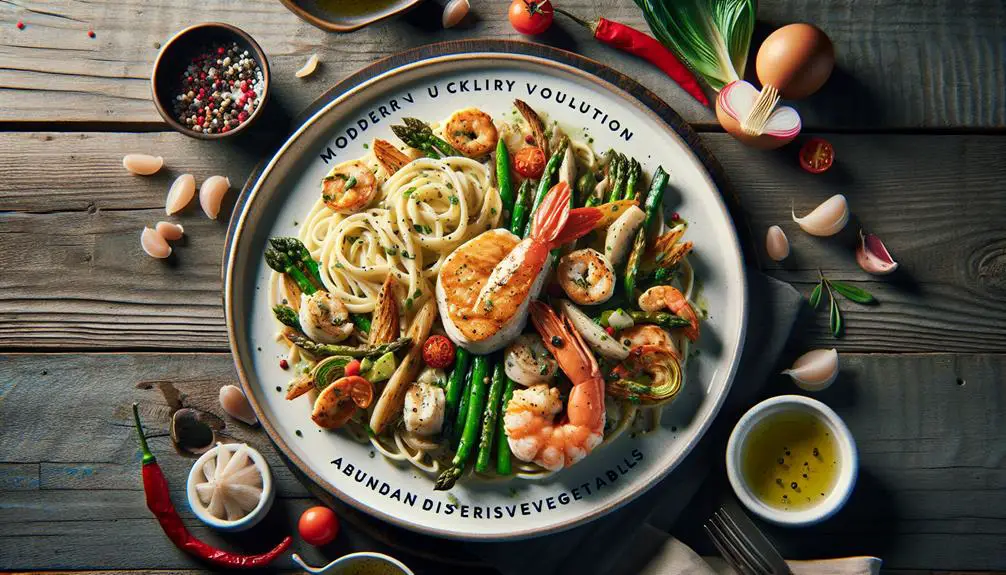
Building upon the foundational simplicity of Alfredo Di Lelio’s classic dish, contemporary Italian-American cuisine has embraced a plethora of modern variations.
For example, Chicken Alfredo incorporates succulent pieces of poultry into the time-honored combination of pasta, butter, and cheese.
This adaptation reflects an analytical understanding of the American palate’s penchant for protein-enriched meals, thus solidifying chicken Alfredo’s status within Italian-American culinary discourse.
The chicken’s inherent flavors and textures synergize with the velvety sauce, offering a diversified sensory experience that honors the dish’s traditional roots while catering to modern tastes.
Furthermore, the evolution of this beloved dish has also given rise to Seafood Alfredo, an alfredo sauce variation that amalgamates various seafood, enhancing the original recipe with a maritime twist.
The integration of ingredients such as shrimp, scallops, and lobster introduces a complexity that diversifies both flavor profiles and textural contrasts within the dish.
Vegetable Alfredo is yet another scholarly nod to the versatility of Alfredo sauce, pairing it with an array of sautéed vegetables to meet burgeoning vegetarian preferences.
This variant maintains the creamy essence while infusing a nutritional dimension into the indulgence.
The exploration of alternative proteins like shrimp further expands the protein options in Alfredo dishes, demonstrating a culinary adaptability that continues to evolve in Italian-American cuisine.
Cultural Impact
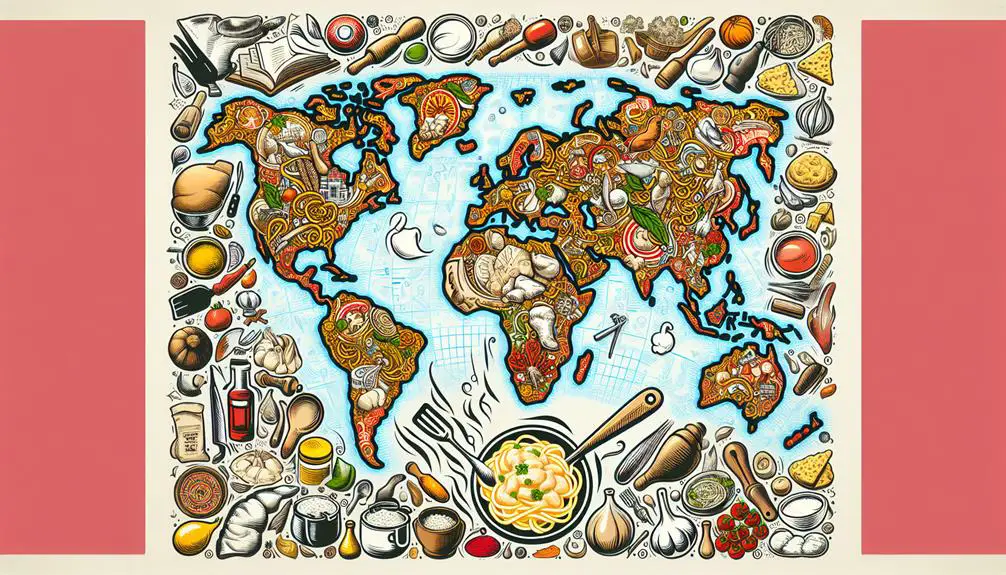
Melding with local palates, Chicken Alfredo has transcended its Roman origins to become a global culinary phenomenon, undergoing regional adaptations and garnering widespread recognition.
As an emblematic dish within Italian cuisine, the fettuccine alfredo recipe has been particularly receptive to cultural impact, inviting fusion with local flavors.
In its journey across continents, Chicken Alfredo has been seamlessly integrated into global cuisines, reflecting a dynamic process of culinary globalization and local customization.
The regional adaptations are a testament to the dish’s versatility and the universal appeal of its creamy, rich sauce. In each locale, the fundamental elements of Chicken Alfredo are reinterpreted, often harmonizing with indigenous ingredients and regional taste preferences.
This scholarly analysis acknowledges the dish’s ability to adapt while maintaining its core identity, a trait that has facilitated its integration and sustained popularity.
The cultural impact of Chicken Alfredo is also evident in its recognition beyond the domain of Italian-themed restaurants. It has become a staple in home cooking repertoires worldwide, underscoring the ease with which this classic dish has been adopted and transformed.
Indeed, Chicken Alfredo exemplifies the fluid nature of culinary traditions and their capacity for innovation within the context of an interconnected gastronomic world.
Culinary Legacy
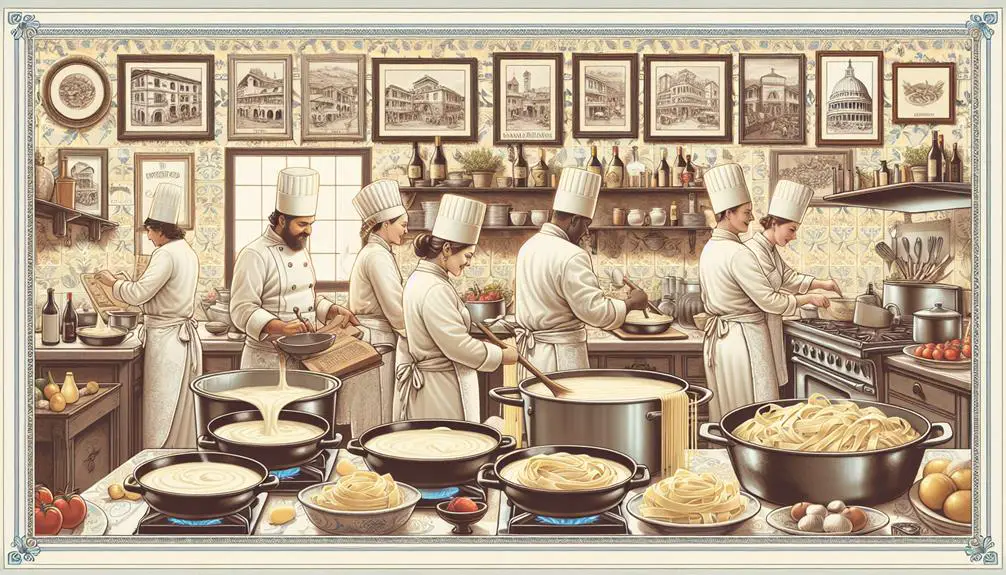
The legacy of Chicken Alfredo as a culinary phenomenon extends far beyond its Roman roots, influencing modern cuisine and significantly impacting both Italian and American culinary landscapes.
Originating from the illustrious alfredo alla scrofa, the dish’s inception by Alfredo Di Lelio set a precedent for a culinary legacy that has transcended generations.
The original recipe, characterized by its simplicity and richness, laid the foundation for numerous interpretations and innovations within gastronomy.
In an analytical exposition of the authentic fettuccine alfredo, the dish’s essence is often noted for its unadulterated amalgamation of butter and Parmesan cheese.
This core has been both preserved and adapted, illustrating the dish’s dual role as a bastion of tradition and a template for creativity.
Noteworthy within this culinary narrative is the addition of chicken, a distinctly American twist that further entrenched the dish within the tapestry of global cuisine.
The culinary legacy of Chicken Alfredo is exemplified by the sustained popularity and menu presence in both quintessentially Italian establishments and American dining franchises.
As a testament to its cultural and gastronomic significance, notable chefs and restaurants continue to honor Alfredo Di Lelio’s legacy, perpetuating the dish’s storied history and its indelible mark on international culinary landscapes.
Common Misconceptions
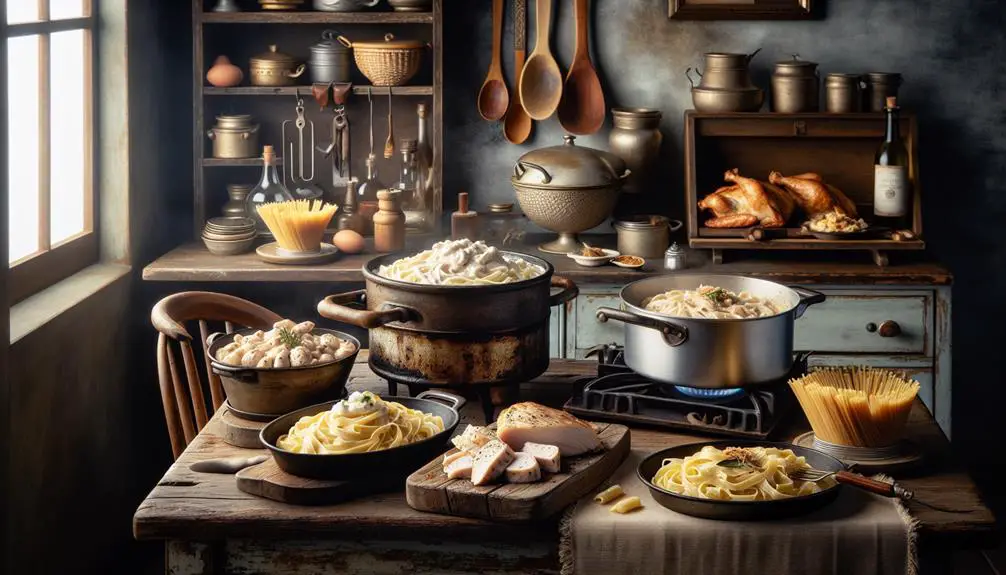
Amidst the plethora of culinary creations, Chicken Alfredo stands out; however, numerous misconceptions surround its authenticity, often leading to a divergence from the original recipe created by Alfredo Di Lelio.
This dish, rooted in the heart of Italian cuisine, has been subjected to a myriad of variations and interpretations, frequently straying from the true Alfredo essence.
The original fettuccine all’Alfredo, a simple concoction of fettuccine, butter, and Parmigiano-Reggiano, has morphed into a dish often laden with cream, chicken, and an array of additional ingredients in international iterations.
Scholarly examination reveals that the authenticity of Chicken Alfredo recipes is frequently compromised by these amendments.
The true Alfredo is characterized by its minimalist approach, emphasizing the quality of its few constituents over the complexity of its flavors. Alfredo Di Lelio’s technique was as critical as the ingredients, ensuring a silky texture and the perfect marriage of pasta and sauce.
Despite the deviations, the culinary world has come to celebrate the diversity of Alfredo interpretations, acknowledging the evolving nature of gastronomy while maintaining respect for the origins.
By recognizing and debunking common misconceptions, chefs and enthusiasts can honor the legacy of Alfredo Di Lelio while appreciating the dish’s global evolution.
Recipe Evolution and Trends

Chefs today are changing the classic Fettuccine Alfredo recipe to make it healthier and fit what people like to eat now. They are using different kinds of pasta, like whole-wheat or pasta that doesn’t have gluten, for people who can’t eat certain foods.
To make the dish less heavy, instead of using a lot of cream, they use things like Greek yogurt or creams made from plants.
They also mix in blended cauliflower to make the sauce creamy and add some good nutrients. Chefs are making sure the recipe is healthy by putting in more veggies to give us more fiber and vitamins, and by using meats that are better for us, like grilled chicken or fish.
These changes are a way to honor where the dish came from while also adding new ideas that fit with how people want to eat today. Turning Fettuccine Alfredo into a healthier meal shows how cooking can change and grow over time.
Wrapping Up
Chicken Alfredo represents a significant evolution from its Roman origins, embodying the fluidity of culinary traditions as they traverse cultures and geographies.
Its incorporation into Italian-American cuisine marks a convergence of taste preferences and innovative adaptations.
The dish’s enduring popularity and continued reinvention reflect broader trends in global gastronomy, illustrating the dynamic nature of culinary heritage and its capacity to meld tradition with contemporary palates in an ever-changing tapestry of flavors and ingredients.
